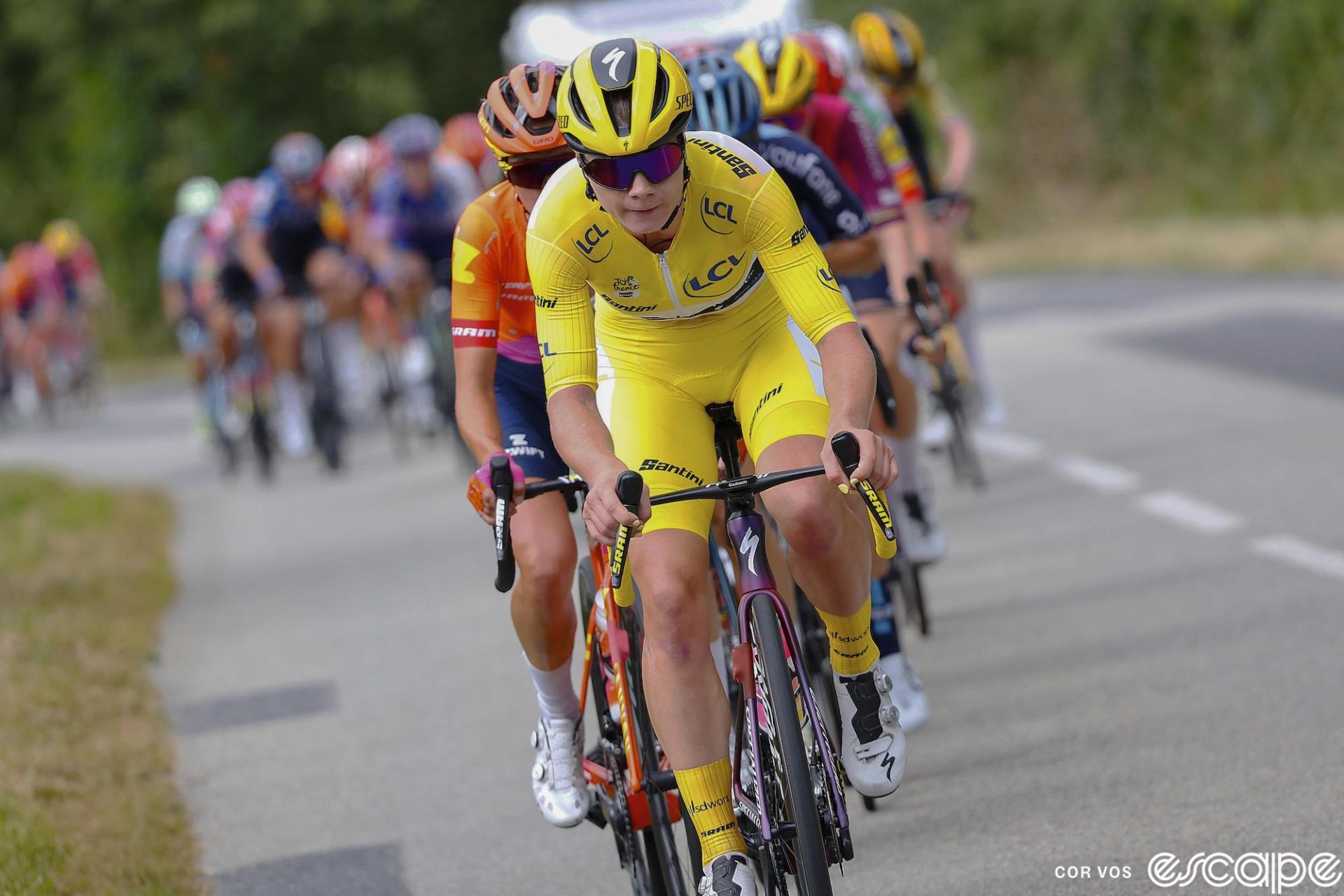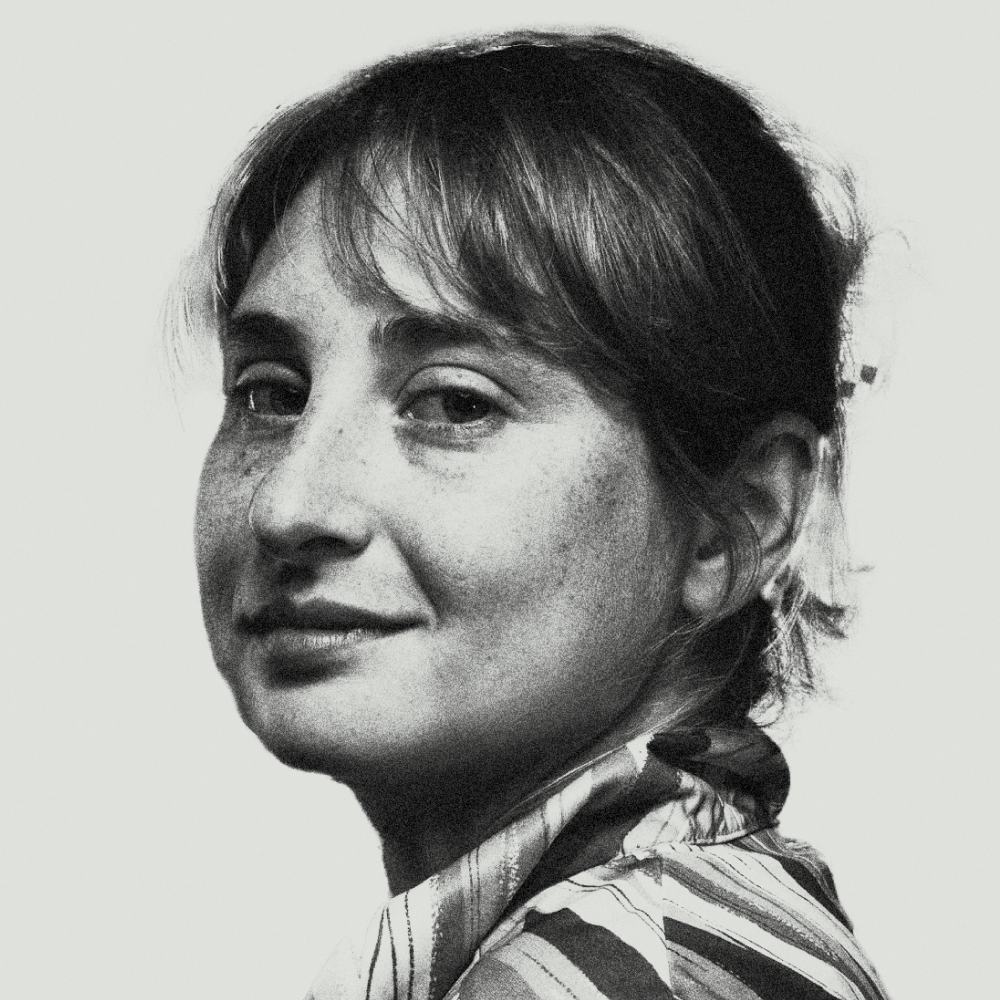Audrey Cordon-Ragot is deep in her drops in the descent.
Behind, her breakaway companions watch as she ekes out her seconds by way of risk. The distance between the 14 of them and the peloton is a staggering eight minutes. There are 41 kilometers to go. To say these conditions are rare in women’s cycling is an understatement. The press room is agog at them. If Cordon-Ragot pulls this off, she, a Frenchwoman in her final years of racing, will be in yellow. Nothing that is happening is expected.
While it does not rain, the sky is dark today. The trees that frame the road capture that darkness and render it in shadow. In that shadow, the break congeals together in anticipation of the upcoming climb. Behind, alarm bells have begun to sound and everyone in the peloton is pulling. Jayco now, but it was SD Worx before that. Surely it will be someone else soon. The pulls are not futile. Seven minutes.
The climb shortens the time even more. In the break, Yara Kastelijn stitches up Cordon-Ragot. The peloton stitches up yet another minute. Stitches up Mischa Bredewold of SD Worx and Elisa Balsamo of Lidl-Trek, who thought they could pull a fast one over them. They are not alone. Lotte Kopecky, the maillot jaune, attacks hard.
Now the mood is really one of panic. Kasia Niewiadoma latches on to Kopecky. The peloton is strung into one long line. It takes that much to bring them back. It takes so much out of everyone. Kathrin Hammes slams on the accelerator in the breakaway, searching for QOM points, in a mirror motion to Kopecky’s that strings the break out too. There are splits. This is the pattern of the day. It will be repeated a hundred times over.
It’s a dangerous game everyone is playing now. The triangulation of times in motion is hard to calculate. How much further ahead is Kastelijn over Cordon-Ragot? Over Kopecky? How much does it matter for the stage, for the GC, now that the gap between the two groups is no more than four minutes? The women labor. You can see it in their shoulders, their open mouths. There is not a single rider in this race who is not motivated. The stage has turned into a collision of interests.
The roads narrows. This descent becomes more and more tricky than the last. Cathedrals made of brown stone pass in a flash. The sun emerges to kiss them. Cordon-Ragot and Kastelijn seek out a few bonus seconds from the ancillary climb. The shadow, the sun again. In the bunch, there are other players emerging, namely Annemiek van Vleuten, and a partner, Emma Norsgaard, waiting, waiting, looking behind. Niewiadoma is right there – she can smell trouble. All it takes is these two women in white insisting on upping the pace for the peloton to shatter.
This, while it is spectacular racing, is terrible for SD Worx, whose strength in numbers is losing the latter, as their women are trapped in between groups, trying to reassemble. Events feel uncontrollable. Three minutes and 18 seconds from break to peloton. Movistar decides to spend Liane Lippert, despite her position in second overall. In the breakaway, the descent is now what turns the group into mere individuals trying to stay together. Elise Chabbey attacks from the peloton. She is snapped back as soon as she goes. Together again, save for the riders whose day is over and who fade back into the cars. Three minutes from break to peloton, 19 kilometers. The hills roll on oblivious to the drama unfolding within their layers.
Kastelijn, as though guided by light, senses her moment on the climb. She wants to dispose of Cordon-Ragot but the Frenchwoman is right on her wheel. This is one of many races being ridden today. It is a battle for the stage and possibly the yellow jersey, though the time is tightening and tightening and tightening. The daylight of minutes has dwindled into the twilight of seconds. These women are forced to act. Kastelijn sees a corner she likes. She clears Cordon-Ragot out of her system.
In the peloton, Kopecky pushes ahead, her teammates behind struggling to make it into her wheel. There are gaps again until there aren’t. But unlike the usual control that grips the bunch, one senses something more frenetic and unsettled is transpiring here, less like a peloton and more like a runaway train. Kastelijn has 10 seconds on Cordon-Ragot, she’s hugging the curve of the road. Kopecky attacks again. It is her jersey. Her lead. Her race. And now we again have a mirror of two scenarios: Kastelijn out front on the breakaway, Kopecky leading ahead of the peloton. A pair, two bunches. Two leaders, two pursuits, two races.
Vollering, Kopecky’s teammate, has had enough. She wants to lock things back in the box of sanity. Perhaps this all part of some grand plan in which Vollering, the GC leader, will join Kopecky later. Perhaps Kopecky just wants her own glory, to honor the shirt she wears. Around them, fans dance in Leclerc t-shirts. Riders drop out the back and pay them no mind. Kopecky winds around the hairpin, Kastelijn is alone. Darkness shrouds the chasers again, nightlike. Kastelijn snags more mountain points – yet another race – but her prize is bigger than that.
There are now many races happening at once: Kastelijn for the stage and potentially the maillot jaune. Cordon-Ragot, chasing, for the maillot jaune. There is the race between break and peloton. There is Kopecky, ahead of the peloton, trying to close the gap threatening her yellow jersey, perhaps to also help Vollering later; one is not exactly sure. There is everyone else behind her, Van Vleuten most especially, thinking of all the others who have been fighting for yellow since stage one.

Kastelijn pedals into the descent, unravels time as fast as she can. There is an urgency in the way she rides. It is not panicked but determined, full of power and will. The final categorized climb lurks around a corner. She pulls a swig from the bottle. Her eyes are always ahead, for surely she knows the time. So are Kopecky’s, the yellow jersey a stark, almost absurd contrast to the darkness of the road. Kastelijn winds up the climb, a minute in her pocket. All pursuers seem to crawl. Ten kilometers. Now the road points up: 10 percent. Riders are shed out the back again. The math: Kastelijn’s virtual GC lead over Kopecky is a handful of seconds. For Cordon-Ragot, that goal is almost a minute out of reach now.
Kopecky looks behind her. Suddenly, Van Vleuten is there with Sheyla Gutiérrez. Her solitude is over. The group, now fractured, consumes her. As soon as this happens, Vollering senses danger and springs into action. Gutiérrez runs interference for her teammate Van Vleuten. Vollering is undeterred when they go with her. Van Vleuten attacks next. Vollering is there, straight on, nipping at her heels. It is pure tension, the tension that emerges between two athletes of great strength. Van Vleuten gives her companion a hard stare. Wariness will reunite these three with their prior companions. Nothing is finished until it is.
Fields emerge around Kastelijn instead of trees. Grasses blow in the breeze she leaves behind her. She is still trying for that yellow jersey. Time for her is fragile, even though she has lots of it, enough, surely to win the stage. She is racing two races with one body.
Perhaps she only has the legs for one.
Four and a half kilometers. Kastelijn needs 24 seconds. She’s doing the bonus math as the cloudy horizon beckons in the distance.
Sensing their critical moment has arrived, Romy Kasper and Juliette Labous attack from what can be called the peloton. Kastelijn’s tongue is out of her mouth. The flamme rouge beckons. This is the most significant bike racing day of her life, and she can see it, the end. Labous is alone now under the two kilometer banner, trying to close those seconds she lost on day one. The GC group hunts her down. Kastelijn is on the final climb. The GC group sees Labous. Kastelijn is pulling every pedal stroke out of her bike with great force. Labous crosses the flamme rouge but the others close in on her. Kastelijn sees the end. She shakes her fist. She grins from ear to ear, awash in sound. She raises her arms in total victory. The chaotic day is finally over for her.
Behind, Van Vleuten and Vollering are locked together as they sweep up riders from the breakaway. Koster tries to hold on from the break but Vollering wants her seconds. When she crosses the line, perplexingly she too celebrates. Perhaps she didn’t know that Kastelijn was out front. Perhaps she’s just happy to have slightly cracked Van Vleuten. There will still be time for that.
The races within this race are over, with balanced results. Kastelijn gets her first pro road win, at the Tour de France no less. Kopecky gets to keep her jersey thanks to her cunning and boldness. Vollering slides into second overall, besting her rival, the World Champion. Rarely is a day so satisfying as it all comes together.
One of the most interesting things about journalism is that we get a chance to confirm our suspicions about what’s happening on a given day. After writing all this, I asked Kastelijn and Kopecky whether there was thought for the yellow jersey in the way they raced; both denied it. Kopecky claims that she wanted to create a bridge to the breakaway or a jumping off point for Vollering to take time on her rivals. Kastelijn was just riding the race of her life.
Neither were aware just how close the jersey came to changing hands – both were merely focused on the stage. The rest, they both said, was merely confusing. But even though the perspectives were different, a race is almost like a form of art; it is up to interpretation – hence all our prodding and analysis. It is also, of course, about feeling.
From across the barriers, Kastelijn hugs her mother who is in tears. The word of the day to describe her is courage. Pure guts. Watching her smile, watching her close her hand over her mouth in disbelief, one realizes that there are no better moments in sport than watching something so monumental happen to someone who so deeply deserves it.
“It was fun,” she tells us, a bright smile on her face, adding another layer to our interpretation.
“I had a nice day in the breakaway, and it was fun.”
What did you think of this story?

